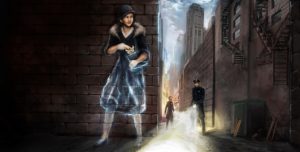Shadowlands
Heed my warning cadet, swear you will not forget: danger and the Shadowland go hand in hand. Ignore me and I promise you this, for without caution you will be missed.
-Cyanberry, Espionage Hall tribune
The Shadowlands is a plane of existence parallel to Blueheim, often described as its muted and duller reflection. It’s neither a separate world nor wholly part of it, it’s something in between the lines. Mercenaries in the Wraith Hall, dalyéwo shamans, ritualists, seers, and witches—anyone who plays with the energies of life and death—invariably flirts with the power coursing through the Shadowlands. Otherworldly creatures and the restless dead inhabit this plane—many are harmless, but don’t make the mistake of thinking the Shadowlands is a place for the living.
Human Religions
When the Radiant Empire conquered humanity in 1267 FA, they abolished all forms of religion except for their own: Trimurtism. The millennium-long suppression of human religions meant virtually none have survived to present day, with only a handful of people still clinging to their faiths. But before the kavi invaded Magna Tellus, hundreds of religions had existed among humans; they had sweeping variations in beliefs, gods, and practices. However, as our understanding of the Shadowlands has broadened, historians have begun to realize every human religion had ancient roots in the study of the Shadowlands. Old texts describing miracles and gods had nothing to do with divine beings and holy powers, but everything to do with the parallel world. Put simply, human religions were the earliest studies of that plane, with many of their practices serving as the basis for what we know today. Among humans, organized religion is all but gone, but its legacy lives on in anyone who studies the Shadowlands.
Ghosts, Spirits, and Wraiths
The term ghost and spirit are used interchangeably by most people—much to the annoyance of those who study the Shadowlands professionally. While both are created from a death and inhabit the Shadowlands, the two are distinctly different entities. A ghost is the emotional imprint created when someone dies in an emotionally-charged state; they are incomplete, more akin to an echo than the person they were created from. Ghosts cannot think or act beyond the cyclic moment of their death. In fact, when most people think of a haunted house, they are thinking of a ghost created in a moment of fear or anger. Unsurprisingly, murders are the leading cause of hauntings.
Spirits, in contrast, are the wholly intact remains of the deceased. They have the same memories and personalities as they did in life, and can think and feel. For most people, after death, their spirits exist briefly in the Shadowlands before moving on to the unknown; an unlucky few don’t, though, and remain trapped there. The exact mechanism for why a spirit is unable to move on is a hotly debated topic, but the prevalent theory is that two criteria must be met: the person had to have a strong connection to the Shadowlands, and they had to die with an unfinished task they feel compelled to complete. Helping a spirit with its unfinished business puts them to rest and allows them to properly move on.
If a spirit remains in the Shadowlands for too long, they begin to transform into something horrific: a Wraith. Wraiths are the twisted shells of spirits that have gone mad from staying in the Shadowlands; they wander the plane, confused and angry, beyond redemption. The creatures are attracted to the living and will swarm toward anyone they sense trespassing in the Shadowlands, tearing apart those they manage to catch.
Daemons
A common misconception about the Shadowlands is that everything there is evil. The truth is there are just as many benevolent and indifferent creatures as there are malevolent. The most powerful of these are called daemons, and it’s more than likely ancient humans based entire religions and cults around their worship.
Shading

Shading is a technique commonly employed by mercenaries in the Espionage Hall. Through rigorous training and the ingestion of special tinctures, they can briefly step into the Shadowlands and infiltrate locations unseen. When a person Shades, they pierce the veil between the physical world and the Shadowlands where it’s weakest: the shadows. The darker a shadow is, the easier it is for someone to Shade through it to the Shadowlands. Once on the other side, they are completely invisible to the naked eye, only detectable by those with the training to sense spiritual energies.
Shading is a dangerous endeavor for the untrained. If the world can be envisioned as a picture, then the Shadowlands would be a transparent film over it, where the laws of physics change dramatically. While in this secondary layer, a person will find it nearly impossible to alter the physical world. They can’t open doors, move people, or stop a mug from spilling; even the air itself becomes an obstacle, creating an unbreathable, high-pressure environment that’s difficult to move through. The physical world is magnified against the one Shading, and this peculiarity poses a substantial risk to anyone doing so recklessly. Small objects from the physical world, such as rain, will still bounce off a person—it will hurt, but it won’t go through them. However, if something larger, like a cat, jumps through a spot where a person is standing in the Shadowlands, the cat feels nothing, but the one Shading will have a cat-shaped hole through them.
The tincture that Espionage Hall mercenaries drink provides a layer of protection against such accidents. It mitigates the force objects from the physical world can exert on the imbiber while they’re in the Shadowlands, allowing them to traverse the plane without worry of minor things cutting through them. Larger objects still pose a serious threat, though, necessitating high levels of situational awareness from anyone who chooses to Shade.
